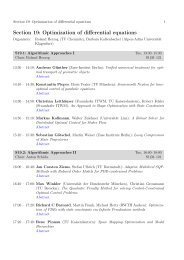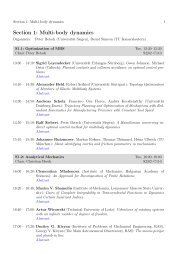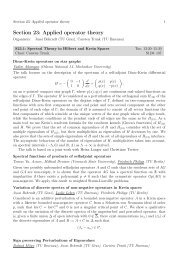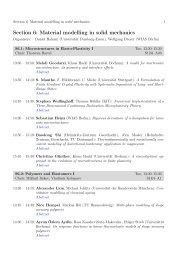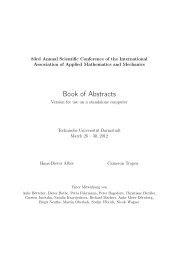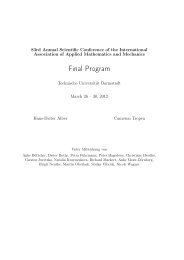Section 6: Material modelling in solid mechanics - GAMM 2012
Section 6: Material modelling in solid mechanics - GAMM 2012
Section 6: Material modelling in solid mechanics - GAMM 2012
Create successful ePaper yourself
Turn your PDF publications into a flip-book with our unique Google optimized e-Paper software.
<strong>Section</strong> 6: <strong>Material</strong> <strong>modell<strong>in</strong>g</strong> <strong>in</strong> <strong>solid</strong> <strong>mechanics</strong> 29<br />
tional order and no translational symmetry, Phys. Rev. Lett. 53 (1984), 1951 – 1953.<br />
[3] T. Fan, Mathematical Theory of Elasticity of Quasicrystals and its Applications, Science<br />
Press Beij<strong>in</strong>g and Spr<strong>in</strong>ger-Verlag Berl<strong>in</strong>, 2011.<br />
On <strong>in</strong>verse form f<strong>in</strong>d<strong>in</strong>g based on an ALE formulation<br />
Sandr<strong>in</strong>e Germa<strong>in</strong>, Paul Ste<strong>in</strong>mann (Universität Erlangen-Nürnberg)<br />
A challenge <strong>in</strong> the design of functional parts <strong>in</strong> form<strong>in</strong>g processes is the determ<strong>in</strong>ation of the<br />
<strong>in</strong>itial, undeformed shape such that under a given load a part will obta<strong>in</strong> the desired deformed<br />
shape. Two numerical methods might be used to solve this problem, which is <strong>in</strong>verse to the<br />
standard k<strong>in</strong>ematic analysis <strong>in</strong> which the undeformed shape is known and the deformed shape<br />
unknown.<br />
The first method deals with the formulation of an <strong>in</strong>verse mechanical problem, where the<br />
spatial (deformed) configuration and the mechanical loads are given. Hence the objective is to<br />
f<strong>in</strong>d the <strong>in</strong>verse deformation map that determ<strong>in</strong>es the (undeformed) material configuration.<br />
The second method deals with shape optimization that predicts the <strong>in</strong>itial shape <strong>in</strong> the sense<br />
of an <strong>in</strong>verse problem via successive iterations of the direct problem. In [1] a nodes-based shape<br />
optimization approach for elastoplastic materials based on logarithmic stra<strong>in</strong>s is presented. An<br />
update of the reference configuration is considered <strong>in</strong> order to avoid mesh distortions, which often<br />
occur <strong>in</strong> nodes-based optimization problems. The pr<strong>in</strong>cipal drawback is the high computational<br />
costs. An alternative is an Arbitrary-Lagrangian-Eulerian (ALE) formulation [2,3], which is neither<br />
purely Lagrangian (the nodes are not attached to the material) nor purely Eulerian (the nodes<br />
are not fixed <strong>in</strong> space). The nodes are free to move <strong>in</strong> space <strong>in</strong>dependently of the material.<br />
In this contribution we review the ALE formulation [2,3] for anisotropic hyperelastic materials<br />
and its application <strong>in</strong> shape optimization. Several examples illustrate the ALE approach <strong>in</strong><br />
hyperelasticity. Results and computational costs are compared with the ones obta<strong>in</strong>ed with the<br />
approach <strong>in</strong> [1].<br />
This work is supported by the German Research Foundation (DFG) with<strong>in</strong> the Collaborative<br />
Research Centre SFB Transregio 73.<br />
[1] S. Germa<strong>in</strong> and P. Ste<strong>in</strong>mann. Towards form f<strong>in</strong>d<strong>in</strong>g methods for a sheet-bulk-metal (DC04),<br />
15th ESAFORM, Key Eng<strong>in</strong>eer<strong>in</strong>g <strong>Material</strong>s submitted (<strong>2012</strong>).<br />
[2] E. Kuhl et al., An ALE formulation based on spatial and material sett<strong>in</strong>gs of cont<strong>in</strong>uum<br />
<strong>mechanics</strong>. Part 1: Generic hyperelastic formulation, Comput. Methods Appl. Mech. Engrg.<br />
193 (2004), 4207 – 4222.<br />
[3] H. Askes et al., An ALE formulation based on spatial and material sett<strong>in</strong>gs of cont<strong>in</strong>uum<br />
<strong>mechanics</strong>. Part 2: Classification and applications, Comput. Methods Appl. Mech. Engrg.<br />
193 (2004), 4223 – 4245.<br />
On the direct connection of rheological elements <strong>in</strong> nonl<strong>in</strong>ear cont<strong>in</strong>uum <strong>mechanics</strong><br />
Ralf Landgraf, Jörn Ihlemann (TU Chemnitz)<br />
The direct connection of rheological elements is a widely used concept to develop material models<br />
for one-dimensional deformation processes at small stra<strong>in</strong>s. This concept is based on the decomposition<br />
of the total stra<strong>in</strong> <strong>in</strong>to several subparts and the formulation of s<strong>in</strong>gle material laws for



